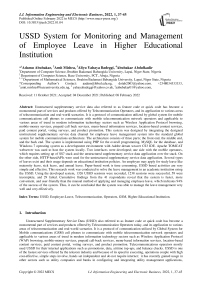USSD System for Monitoring and Management of Employee Leave in Higher Educational Institution
Автор: Adamu Abubakar, Amit Mishra, Aliyu Yahaya Badeggi, Abubakar Abdulkadir
Журнал: International Journal of Information Engineering and Electronic Business @ijieeb
Статья в выпуске: 1 vol.14, 2022 года.
Бесплатный доступ
Unstructured supplementary service data also referred to as feature code or quick code has become a monumental part of services and products offered by Telecommunication Operators, and its application to various areas of telecommunication and real-world scenarios. It is a protocol of communication utilized by global system for mobile communications cell phones to communicate with mobile telecommunication network operators and applicable to various areas of trend in modern information technology sectors such as Wireless Application Protocol browsing, mobile-money services, prepaid call back services, menu-based information services, location-based content services, paid content portal, voting surveys, and product promotion. This system was designed by integrating the designed unstructured supplementary service data channel for employee leave management system into the standard global system for mobile communications architecture. The architecture consists of three parts; the front end, the middle end, and the back end. The system is implemented using PHP for the overall programming, MySQL for the database, and Windows 7 operating system as a development environment with Adobe dream weaver CS3 IDE. Apache TOMCAT webserver was used to host the system locally. Two interfaces were developed; one side with the mobile operators, which requires setting up of SS7 stack and the unstructured supplementary service data application over the stack. On the other side, HTTP-basedAPIs were used for the unstructured supplementary service data application. Several types of leaves exist and their usage depends on educational institution policies. An employee may apply for study leave like maternity leave, sick leave, and annual leave. Paper-based work is time consuming, USSD based activities are very simple and effective. This research work was conducted to solve the leave management in an academic institution using the USSD. Using the developed system, 1326 USSD sessions were recorded, 1238 sessions were successful, 59 were incomplete, and 29 failed. Cumulative findings from the 41 respondents reveal that the system is faster, more convenient, and user-friendly than the manual method of applying and managing employee leave, which indicates 94% of the success of the system. Thus, it can be concluded that the system was able to manage the leave management very well and very effectively.
USSD, Employee-Leave, Telecommunication, Operators, GSM, Higher-Educational Institution
Короткий адрес: https://sciup.org/15018320
IDR: 15018320 | DOI: 10.5815/ijieeb.2022.01.04
Список литературы USSD System for Monitoring and Management of Employee Leave in Higher Educational Institution
- Kawu, A. A. Abdullahi, A., Joseph, E., Mishra, A. and Abdulrahman, A. (2020). A mobile USSD-SMS Interactive Result Checking System for Resource Constrained Settings. Proceedings of 2020 9th International Conference on Software and Computer Applications, Langkawi, Malaysia
- Adamu, A. (2020). Employee Leave Management System. FUDMA Journal of Sciences (FJS). Vol. 4 No. 2, Pp 86-87.
- Gupta, P. (2010). End to End USSD Implementation. TATA Tele Service Ltd, India.
- Moses, M. T., Joseph, K. S. and Jason, G. (2013). An SMS USSD Model Location-Based Mobile Advertising. International Journal of Computer Science and Engineering Technology pp 107.
- Rob, L., Juma, L., Yola, G. and Jeroen, V. (2017). Monitoring Rural Water Points in Tanzania with Mobile Phones: The Evolution of the SEMA APP. International Journal of 15Geo-Information.
- Ojo, A. K. and Ogundare, M. A. (2018). Offline Accessible System for Agricultural ECommerce Using unstructured Supplementary Service Data Application. International Journal of Computer Science and Telecommunication 9(06) PP 5.
- Baraka, W. N., Anael, S. and Loserian, S.L. (2013). Security Perpective for USSD Verses SMS in Conducting Mobile Tranactions. International Journal of Technology Enhancements and Emerging Research 01(03). Pp 38.
- Hridita, A. (2018). Employee leave Management System in Metlife Bangladesh. An Intenship Report on Meltlife.
- Mishal, R., Prity, S., Prachir C. and Arhant, C. (2017). Employee Leave Management System. International Journal of Advance Research and Innovative Ideas in Education. 03(05).
- Manish, S., Prachi, S., Rohil, Shubham, S. and Shiwani, S. (2015). Leave and Payroll Management System. International Conference on Computing and Virtualization, Thakur, India.
- Rushitha, E., Preethi, G., Harshita, N.M., Manisha, R.R. and Veena, M. (2019). Android Leave Management System. International Research Journal of Computer Science. 06(6).
- Isaac, U.O., Sanjay, M., Robertas, D. and Rytis, M. (2018). Cloud Based Simple Employee Management Information System: A Model for African Small and Medium Enterprises.
- Vikrant, K.K., Arjun, K.G., Ashish, K., and Abhishek, P. (2017). Student Leave Management System. International Journal of Advance Research and Innovative Ideas in Education. 03(05). Pg 124
- Stephen, B.U. and Chukwudebe, G.A., Dike, D.O. and Chukwuchewa, N. (2018). Improved Leave Schedulling Algorithm for Improved Service Delivery in Nigeria University System. Nigerian Journal of Technology. 4(37). Pg 1039.
- Sanaganagouda, J. (2011). USSD: A Potential Communication Technology that can Ouster SMS Dependency. International Journal of Reseach and Reviews in Computer Science 02(02). Pp10.


